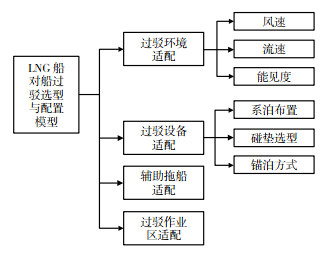A Study of Configuration Model and Safety Analysis for Ship-to-ship Transfers of Liquefied Natural Gas
-
摘要: 针对LNG船对船过驳作业中设备选型与配置问题, 利用多层次模糊综合评判分析并系统性地构建了LNG船对船过驳作业配置模型, 提出了LNG船对船过驳设备配置稳定性的定量分析方法和计算流程, 以145 000 m3和60 000 m3的LNG船舶为试验对象, 利用计算流体动力学(CFD)技术对2船组合体配置系统开展仿真试验分析, 并基于仿真试验结果开展了该模拟工况条件下LNG船对船过驳选型适配度的计算。结果表明: 在模拟工况下LNG船对船过驳选型与配置适配度为0.85, 与最优值1.00的误差为15%, 在20%的误差允许范围内, 验证了所提出的LNG船对船过驳作业选型与配置模型的有效性; 同时, 明确了LNG船对船过驳作业的环境限制条件应为能见度大于1 000 m, 风力小于6级, 流速小于2.5 n mile/h, 过驳作业安全区半径范围为1 210 m。采用所构建的过驳作业选型与配置模型能够实现LNG船对船过驳作业设备选型与配置安全稳定性的量化分析和确定具有普适性的LNG船对船过驳作业限制条件, 对于保障LNG船对船过驳作业关键配置选型的安全性具有重要意义。Abstract: To address the problem of equipment selection and configuration for LNG ship-to-ship barge operation, a configuration model is systematically developed based on the multi-level fuzzy comprehensive evaluation analysis.A quantitative analysis method is proposed to calculate the stability of LNG ship-to-ship transfer equipment. Taking145 000 m3 and 60 000 m3 LNG ships as test objects, simulation analysis of the assembly configuration system is carried out based on the Computational Fluid Dynamics(CFD) method. The goodness of fit analysis under the simulated conditions are carried out based on the configuration model of LNG ship-to-ship transfer operation. According to the results, the goodness of fit of the selection and configuration of LNG ship-to-ship transfer under the simulated working condition is 0.85, whose error between the optimal value is 15% that is within the allowable range of 20%.It verifies the proposed LNG ship-to-ship transfer select and configuration model. Meanwhile, the LNG ship-to-ship transfer operation is restricted by the visibility greater than 1 000 m, a wind speed of less than 10.8 m/s, a flow rate of less than 2.5 n mile/h, and a safety zone radius of 1 210 meters. The configuration model can not only be used to provide quantitative safety analysis of the configuration for LNG ship-to-ship transfer equipment, but also to set up the environmental restriction conditions of LNG ship-to-ship transfer operation.
-
表 1 权重值的计算结果
Table 1. Calculation results of weight values
二级指标 权重值ωi 三级指标 权重值ωij 风速 0.69 过驳环境适配 0.65 流速 0.56 能见度 0.72 系泊布置 0.75 过驳设备适配 0.66 碰垫选型 0.58 锚泊方式 0.66 辅助拖轮适配 0.58 过驳作业区适配 0.77 表 2 碰垫快速选取表
Table 2. Parameters of fender selection
靠泊系数C/t 抵靠速度v/(m/s) 靠泊能量/(kN·m) 碰垫数量/个 高压碰垫尺寸/(m×m) 1 000 0.30 24 ≥ 3 1.0×2.0 3 000 0.30 70 ≥ 3 1.5×3.0 6 000 0.30 140 ≥ 3 2.5×5.5 10 000 0.25 170 ≥ 3 2.5×5.5 30 000 0.25 400 ≥ 4 3.3×6.5 50 000 0.20 480 ≥ 4 3.3×6.5 100 000 0.15 540 ≥ 4 3.3×6.5 150 000 0.15 710 ≥ 5 3.3×6.5 200 000 0.15 930 ≥ 5 3.3×6.5 330 000 0.15 1 550 ≥ 4 4.5×9.0 500 000 0.15 2 310 ≥ 4 4.5×9.0 表 3 锚的抓力系数和锚链的摩擦系数
Table 3. Coefficient of anchor holding and chain friction
底质 λa λc 底质 λa λc 软泥 10 3 砂贝壳 7 2 硬泥 9 2 沙砾 6 1.5 砂泥 8 2 小块石 5 1.5 砂 7 2 表 4 LNG船舶设计参数
Table 4. Parameters of the LNG ships
项目类型 LNGU LNGR 船长Loa/m 292.0 216.0 垂线间长Lbp/m 278.0 205.0 船宽B/m 43.4 34.0 型深D/m 26.3 17.7 吃水T/m 11.4 9.0 排水量∆/t 114 700 51 900 横摇惯性半径Kxx/m 14.8 11.6 纵摇惯性半径Kyy/m 73.0 54.0 艏摇惯性半径Kzz/m 76.0 56.0 表 5 风浪流环境条件参数
Table 5. Parameters of environmental condition
环境条件 参数 类型数值 风谱 NPD谱 风 风速Vw/(m/s) 7.9 风向Cw/(°) 180 类型 定常流 流 流速Vc/(m/s) 1 流向Cc/(°) 180 波浪谱 JONSWAP谱 有义波高Hs/m 1.25 浪 Gamma 3.3 谱峰周期T/Hz 0.25 浪向Ce/(°) 180 表 6 LNG船对船过驳设备参数
Table 6. Equipment parameters of LNG ship-to-ship transfer
设备 参数 类型数值 缆绳 船艏/根 8 船舯/根 4 船艉/根 6 破断强度/kN 1 774 碰垫 数量/个 4 尺寸/(m×m) 3.3×6.5 破断强度/kN 2 460 锚 锚泊方式 单锚锚泊 破断强度/kN 14 970 拖船 拖船数量/艘 3 布置方式 受载船配置 表 7 模拟工况设置情况
Table 7. Simulate settings of each scenarios
序号 风力等级 流速/(n mile/h) 能见度/m 适配度 相符误差值/% 1 4 1 2 000 0.857 4.8 2 5 1 2 000 0.852 5.2 3 6 1 2 000 0.764 15.1 4 7 1 2 000 0.648 28.0 5 4 1.5 2 000 0.864 3.9 6 4 2 2 000 0.851 5.5 7 4 2.5 2 000 0.755 16.1 8 4 3 2 000 0.716 20.5 9 4 3.5 2 000 0.701 22.1 10 4 1 1 500 0.867 3.6 11 4 1 1 000 0.864 4.0 12 4 1 500 0.780 13.3 13 4 1 200 0.667 25.9 表 8 适配度的计算结果
Table 8. Calculation results of goodness of fit
二级指标 三级指标 指标实测值dij 指标最优值d'ij 适配度实测值 适配度最优值 过驳环境适配 风速 7.9 12.3 0.85 1.00 流速 1.0 1.3 能见度 2 000 1 000 过驳设备适配 系泊布置 1 315 1 770 碰垫选型 2 145 2 460 锚泊方式 817 1 000 辅助拖船适配 3 3 过驳作业区适配 1 210 1 500 -
[1] 李剑, 佘源琦, 高阳, 等. 中国天然气产业发展形势与前景[J]. 天然气工业, 2020, 40(4): 133-142. doi: 10.3787/j.issn.1000-0976.2020.04.017LI J, SHE Y Q, GAO Y, et al. Natural gas industry in China: Development situation and prospect[J]. Natural Gas Industry, 2020, 40(4): 133-142. (in Chinese) doi: 10.3787/j.issn.1000-0976.2020.04.017 [2] 马金晶, 皇甫立霞, 韩力, 等. 国内外LNG内河运输安全标准现状及展望[J]. 天然气工业, 2015, 35(12): 117-123. doi: 10.3787/j.issn.1000-0976.2015.12.018MA J J, HUANGPU L X, HAN L, et al. Current status and prospect of LNG inland water transportation safety standards at home and abroad[J]. Natural Gas Industry, 2015, 35(12): 117-123. (in Chinese) doi: 10.3787/j.issn.1000-0976.2015.12.018 [3] 梅强, 胡勤友, 刘希亮, 等. 全球LNG海上运输网络演化及中国贸易现状分析[J]. 地球信息科学学报, 2022, 24(9): 1701-1716. https://www.cnki.com.cn/Article/CJFDTOTAL-DQXX202209006.htmMEI Q, HU Q Y, LIU X L, et al. Evolution of global LNG maritime transport network and analysis of China's trade status[J]. Journal of Geoinformation Science, 2022, 24(9): 1701-1716. (in Chinese) https://www.cnki.com.cn/Article/CJFDTOTAL-DQXX202209006.htm [4] 于文杰, 郭国平, 吴兵. 基于模糊故障树的长江LNG船舶装卸作业风险预测[J]. 交通信息与安全, 2019, 37(5): 46-53. doi: 10.3963/j.issn.1674-4861.2019.05.007YU W J, GUO G P, WU B. Risk prediction of LNG ships during loading/unloading in the Yangtze river based on fuzzy fault tree[J]. Journal of Transport Information and Safety, 2019, 37(5): 46-53. (in Chinese) doi: 10.3963/j.issn.1674-4861.2019.05.007 [5] SUN L P, HE Q. Safety assessment for a side-by-side offloading mooring system[J]. Journal of Marine Science and Application, 2011, 10(3): 315-320. doi: 10.1007/s11804-011-1074-1 [6] GU J Y, YANG J M, LU H N. Numerical simulations and model tests of the mooring characteristic of a tension leg platform under random waves[J]. China Ocean Engineering, 2013, 27(5): 563-578. doi: 10.1007/s13344-013-0048-2 [7] 徐铁, 危强. 超大型LNG船舶靠离泊所需拖船总功率研究[J]. 船海工程, 2014, 43(2): 97-100. https://www.cnki.com.cn/Article/CJFDTOTAL-WHZC201402027.htmXU T, WEI Q. Research on total power of tugs for ultra large LNG carrier's berthing and unberthing[J]. Ship and Ocean Engineering, 2014, 43(2): 97-100. (in Chinese) https://www.cnki.com.cn/Article/CJFDTOTAL-WHZC201402027.htm [8] 张明霞, 裴斐, 刘镇方, 等. 基于AQWA的FPSO串靠提油作业中的拖船适用性评估[J]. 中国海洋平台, 2017, 32(4): 34-42. doi: 10.3969/j.issn.1001-4500.2017.04.006ZHANG M X, PEI P, LIU Z F, et al. Suitability assessment of tug for offloading in Tandem between FPSO and shuttle tanker based on AQWA[J]. China Offshore Platform, 2017, 32(4): 34-42. (in Chinese) doi: 10.3969/j.issn.1001-4500.2017.04.006 [9] YUE J, KANG W, MAO W, et al. Prediction of dynamic responses of FSRU-LNGC side-by-side mooring system[J]. Ocean Engineering, 2019(195): 106731. [10] 施兴华, 于泽群, 章柯, 等. FPSO与穿梭油船的旁靠时域分析及系统优化[J]. 中国舰船研究, 2020, 15(1): 127-135. https://www.cnki.com.cn/Article/CJFDTOTAL-JCZG202001016.htmSHI X H, YU Z Q, ZHANG K, et al. Time domain analysis and system optimization of side-by-side mooring for FPSO and shuttle tanker[J]. Chinese Journal of Ship Research, 2020, 15(1): 127-135. (in Chinese) https://www.cnki.com.cn/Article/CJFDTOTAL-JCZG202001016.htm [11] 张新福, 王琦, 吴立洋. 并靠状态下潜没式护舷力学性能分析[J]. 船舶工程, 2020, 42(10): 68-73. https://www.cnki.com.cn/Article/CJFDTOTAL-CANB202010017.htmZHANG X F, WANG Q, WU L Y. Analysis of mechanical properties of submerged fender under side-by-side condition[J]. Ship Engineering, 2020, 42(10): 68-73. (in Chinese) https://www.cnki.com.cn/Article/CJFDTOTAL-CANB202010017.htm [12] 齐奎利, 赵亚坤, 刘磊, 等. LNG旁靠FSRU码头系泊的水动力性能试验研究[J]. 船舶力学, 2021, 25(6): 760-771. doi: 10.3969/j.issn.1007-7294.2021.06.008QI K L, ZHAO Y K, LIU L, et al. Experimental investigation on the hydrodynamic performance of quay-moored FSRU and LNG carrier[J]. Journal of Ship Mechanics, 2021, 25(6): 760-771. (in Chinese) doi: 10.3969/j.issn.1007-7294.2021.06.008 [13] SULTANA S, OKOH P, HAUGEN S, et al. Hazard analysis: Application of STPA to ship-to-ship transfer of LNG[J]. Journal of Loss Prevention in the Process Industries, 2019(60): 241-252. [14] 朱明昌, 黄立文, 谢澄, 等. 基于STAMP/STPA的LNG船对船过驳系统安全性分析[J]. 交通信息与安全, 2021, 39(6): 44-53. doi: 10.3963/j.jssn.1674-4861.2021.06.006ZHU M C, HUANG L W, XIE C, et al. Safety analysis of LNG ship-to-ship transit system based on STAMP/STPA[J]. Journal of Transport Information and Safety, 2021, 39(6): 44-53. (in Chinese) doi: 10.3963/j.jssn.1674-4861.2021.06.006 [15] TAM J H. Overview of performing shore-to-ship and ship-to-ship compatibility studies for LNG bunker vessels[J]. Journal of Marine Engineering and Technology, 2020, 21(5): 1-14. [16] ZOU L, LARSSON L. Numerical predictions of ship-to-ship interaction in shallow water[J]. Ocean Engineering, 2013(72): 386-402. [17] 李永福, 梁圣荧, 矫珊珊, 等. 大型LNG船系泊安全分析[J]. 船舶与海洋工程, 2020, 36(3): 5-11. https://www.cnki.com.cn/Article/CJFDTOTAL-SHZC202003002.htmLI Y F, LIANG S Y, JIAO S S, et al. Large LNG carrier mooring safety evaluation[J]. Naval Architecture and Ocean Engineering, 2020, 36(3): 5-11. (in Chinese) https://www.cnki.com.cn/Article/CJFDTOTAL-SHZC202003002.htm [18] 孟祥玮, 高学平, 张文忠, 等. 波浪作用下船舶系缆力的计算方法[J]. 天津大学学报(自然科学与工程技术版), 2011, 44(7): 593-596. https://www.cnki.com.cn/Article/CJFDTOTAL-TJDX201107007.htmMENG X W, GAO X P, ZHANG W Z, et al. A calculation method of mooring force induced by waves[J]. Journal of Tianjin University(Science and Technology), 2011, 44(7): 593-596. (in Chinese) https://www.cnki.com.cn/Article/CJFDTOTAL-TJDX201107007.htm [19] Oil Companies International Marine Forum. Mooring equipment guidelines[S]. Glasgow: Bell & Bain Ltd, 2018. [20] 中华人民共和国交通部. 港口工程荷载规范: JTS 144-1—2010[S]. 北京: 人民交通出版社, 2010.Ministry of Transport, People's Republic of China. Load code for harbour engineering: JTS 144-1—2010[S]. Beijing: China Communications Press, 2010. (in Chinese) [21] Oil Companies International Marine Forum. Ship to ship transfer guide for petroleum: Chemicals and liquefied Gases[S]. Glasgow: Bell & Bain Ltd, 2013. [22] MAKSYM K, DAVID A W. LNG cargo Handing-1: new approach improves ship-to-ship LNG transfers[J]. Oil and Gas Journal, 2017, 115(11): 65-70. [23] 于洋. 海洋运输船舶首锚重量统计分析[J]. 大连海事大学学报, 2016, 42(4): 33-40. https://www.cnki.com.cn/Article/CJFDTOTAL-DLHS201604006.htmYU Y. A statistic analysis of bow anchor weights of sea-going merchant ships[J]. Journal of Dalian Maritime University, 2016, 42(4): 33-40. (in Chinese) https://www.cnki.com.cn/Article/CJFDTOTAL-DLHS201604006.htm [24] SANO M, YASUKAWA H. Maneuverability of a combined two-ship unit engaged in underway transfer[J]. Ocean Engineering, 2019(173): 774-793. [25] GAUVIN B. Two big ASD tugs custom-designed for moving LNG tankers[J]. Professional Mariner, 2012(154): 24-25. [26] XIE C, DENG J, ZHUANG Y, et al. Estimating oil pollution risk in environmentally sensitive areas of petrochemical terminals based on a stochastic numerical simulation[J]. Marine Pollution Bulletin, 2017, 123(1/2): 241-252. [27] 文元桥, 杜磊, 王乐, 等. LNG船舶锚泊安全距离定量计算建模[J]. 安全与环境学报, 2015, 15(4): 134-139. https://www.cnki.com.cn/Article/CJFDTOTAL-AQHJ201504030.htmWEN Y Q, DU L, WANG L, et al. Quantitative model for determining the safety distance of anchoring LNG carriers[J]. Journal of Safety and Environment, 2015, 15(4): 134-139. (in Chinese) https://www.cnki.com.cn/Article/CJFDTOTAL-AQHJ201504030.htm [28] 乐京霞, 康伟利, 陈鹏飞, 等. FSRU-LNGC旁靠作业运动响应[J]. 船舶工程, 2019, 41(1): 110-116. https://www.cnki.com.cn/Article/CJFDTOTAL-CANB201901024.htmYUE J X, KANG W L, CHEN P F, et al. Dynamic response of the FSRU-LNGC in side-by-side operation[J]. Ship Engineering, 2019, 41(1): 110-116. (in Chinese) https://www.cnki.com.cn/Article/CJFDTOTAL-CANB201901024.htm [29] DECO A, FRANGOPOL D M. Real-time risk of ship structures integrating structural health monitoring data: Application to multi-objective optimal ship routing[J]. Ocean Engineering, 2015(96): 312-329. -





 下载:
下载:












